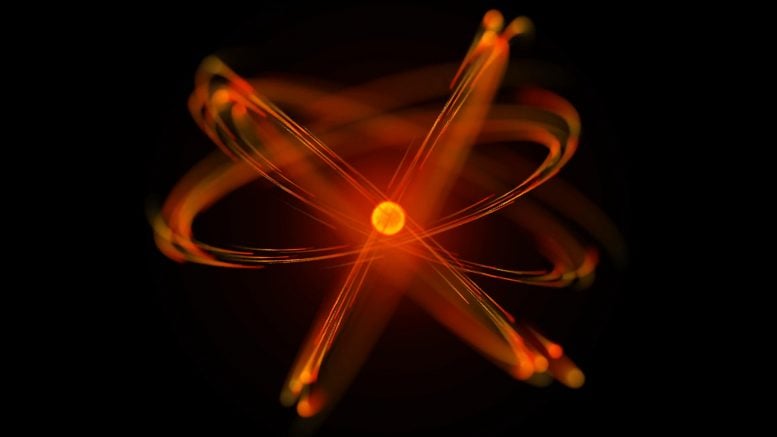
The neutron’s decay time remains a mystery, and scientists are striving to determine its lifetime precisely.
Nine seconds. An eternity in some scientific experiments; an unimaginably small amount in the grand scheme of the universe. And just long enough to confound nuclear physicists studying the lifetime of the neutron.
The neutron is one of the building blocks of matter, the neutral counterpart to the positive proton. Like many other subatomic particles, the neutron doesn’t last long outside of the nucleus. Over the course of about 15 minutes, it breaks apart into a proton, an electron, and a tiny particle called an anti-neutrino.
But how long the neutron takes to fall apart presents a bit of a mystery. One method measures it as 887.7 seconds, plus or minus 2.2 seconds. Another method measures it as 878.5 seconds, plus or minus 0.8 seconds. At first, this difference seemed to be a matter of measurement sensitivity. It may be just that. But as scientists continue to perform a series of ever-more-precise experiments to evaluate possible issues, the discrepancy remains.
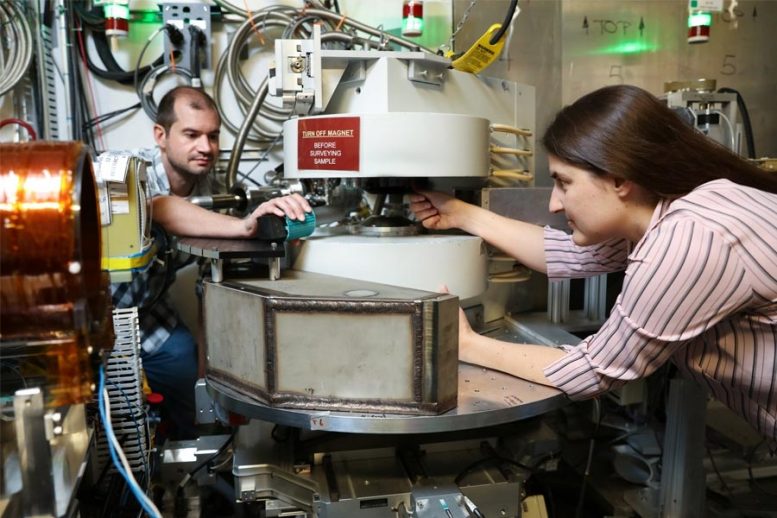
From left, ORNL staff Matthew Frost and Leah Broussard work at the Magnetism Reflectometer at the Spallation Neutron Source, used for a search for mirror neutrons. Credit: Genevieve Martin /Oak Ridge National Laboratory, U.S. Dept. of Energy
This persistence leads to the possibility that the difference is pointing to some type of unknown physics. It could be revealing an unknown process in neutron decay. Or it could be pointing to science beyond the Standard Model scientists currently use to explain all of particle physics. There are a number of phenomena that the Standard Model doesn’t fully explain and this difference could point the way towards answering those questions.
To unravel this strange disparity, the Department of Energy’s (DOE) Office of Science is working with other federal agencies, national laboratories, and universities to nail down the duration of the neutron lifetime.
A Fundamental Quantity
Nuclear physicists first started studying the neutron lifetime because of its essential role in physics. “There are some fundamental quantities in nature that seem to be always important,” said Geoff Greene, University of Tennessee professor and physicist at DOE’s Oak Ridge National Laboratory. He’s been researching the neutron lifetime for much of his lifetime — about 40 years. “Theories come and go, but the neutron lifetime seems to remain a central parameter in a variety of things.”
The neutron is a useful guide to understanding other particles. It’s the simplest particle that is radioactive, which means that it regularly breaks down into other particles. As such, it provides a lot of insight into the weak force, the force that determines if neutrons turn into protons or not. Often, this process releases energy and causes the nuclei to break apart. The interactions of the weak force also play an important role in nuclear fusion, where two protons combine.
The neutron lifetime may also provide insight into what happened just moments after the Big Bang. In the few seconds after protons and neutrons formed but before they joined together into elements, there was a precise bit of timing. The universe was cooling rapidly. At a certain point, it got cool enough that protons and neutrons almost instantaneously joined to form helium and hydrogen. If neutrons decayed a little faster or slower into protons, it would have vast effects on that process. There would be a very different balance of elements in the universe; it’s likely that life wouldn’t exist.
“It’s one of those fortuitous accidents of nature that we have chemical elements at all,” said Greene. Scientists would like to have a solid number for the neutron lifetime to plug into these equations. They need the uncertainty of the lifetime down to less than a second. But getting this certainty is more difficult than it initially seemed. “The neutron lifetime is one of the least well-known fundamental parameters in the Standard Model,” said Zhaowen Tang, a physicist at DOE’s Los Alamos National Laboratory (LANL).
Individual experiments have been able to reach this level of precision. But the incongruity between different types of experiments is preventing scientists from nailing down a specific number.
Discovering a Discrepancy
Finding out there was a difference at all arose from physicists’ desire to be comprehensive. Using two or more methods to measure the same quantity is the best way to guarantee an accurate measurement. But scientists can’t put timers on neutrons to see how fast they fall apart. Instead, they find ways to measure neutrons before and after they decay to calculate the lifetime.
Beam experiments use machines that create streams of neutrons. Scientists measure the number of neutrons in a specific volume of the beam. They then send the stream through a magnetic field and into a particle trap formed by an electric and magnetic field. The neutrons decay in the trap, where the scientists measure the number of protons left in the end.
“The beam experiment is a really hard way to do a precision measurement,” said Shannon Hoogerheide, a physicist at the National Institute of Standards and Technology (NIST), who has collaborated with DOE scientists. “The beam measurement requires not one, but two absolute measurements.”
In contrast, bottle experiments trap ultra-cold neutrons in a container. Ultra-cold neutrons move much slower than regular ones — a few meters per second compared to the 10 million meters per second from fission reactions. Scientists measure how many neutrons are in the container at the beginning and then again after a certain period of time. By examining the difference, they can calculate how fast the neutrons decayed.
“The bottle experiment measures the survivors, the beam experiment measures the dead,” said Greene. “The bottle experiment sounds easy but actually is very hard. On the other hand, the beam experiment sounds hard and is hard.”
A beam experiment at NIST in 2005 (with support from DOE) and a bottle experiment in France not long after first revealed the difference in measurement. Since then, experiments have tried to reduce the space between the two by minimizing as many uncertainties as possible.
Greene and his collaborators took new measurements in 2013 at NIST that helped them recalculate the 2005 beam experiment even more accurately. By that point, scientists had completed five bottle and two beam experiments. Greene was convinced that previous beam experiments had missed one of the biggest sources of uncertainty — precisely counting the number of neutrons in the beam. They improved their measurement of this variable to make it five times more accurate. But eight years of hard work left them with almost the exact same gap in results.
Physicists working on bottle experiments faced their own struggles. One of the biggest challenges was to keep the neutrons from getting lost from interactions with the material the container is made of. A leak changes the number of neutrons at the end and throws off the lifetime calculation.
To solve this problem, the most recent bottle experiment at LANL (which was supported by the Office of Science) eliminated physical walls. Instead, the nuclear physicists used magnetic fields and gravity to hold the neutrons in place. “I was in the camp of, if we do that, we might get a neutron to live longer and agree with the beam lifetime,” said Chen-Yu Liu, an Indiana University professor who led the experiment. “That was my personal bias.”
But the difference remained. “That was a big shock to me,” she said, describing the result published in 2018. The odds of that difference happening from random chance are less than 1 in 10,000. But it could still be caused by a flaw in the experiments.
Hunting Down the Root Cause
Scientists face two types of uncertainties or errors in experiments: statistical or systematic. Statistical errors come from not having enough data to draw solid conclusions. If you can get more data, you can reliably lower those errors. Systematic errors are fundamental uncertainties with the experiment. Many times, they’re far from obvious. The two types of neuron lifetime experiments have vastly different potential systematic errors. The experiments would be a great check on each other if the results matched. But it makes it devilishly hard to figure out why they don’t.
“The hardest thing about measuring the neutron lifetime is that it’s both too short and too long,” said Hoogerheide. “It turns out 15 minutes is a really awkward time to measure in physics.”
So nuclear scientists are continuing work to collect more data and minimize systematic errors.
“One of the things that I find most fun about my field is the exquisite attention to detail required and how deeply you have to understand every aspect of your experiment in order to make a robust measurement,” said Leah Broussard, a nuclear physicist at ORNL.
At NIST, Hoogerheide, Greene, and others are running a new beam experiment that walks through each possible issue in as comprehensive a way as possible. Unfortunately, each tweak affects the others, so it’s two steps forward, one step back.
Other efforts are looking into new ways to measure the neutron lifetime. Researchers from Johns Hopkins University and the U.K.’s Durham University supported by DOE figured out how to use data from NASA to measure the neutron lifetime. Based on neutrons coming off of Venus and Mercury, they calculated a lifetime of 780 seconds with an uncertainty of 130 seconds. But because the data collection wasn’t designed for this purpose, the uncertainty is too high to resolve the lifetime difference. At LANL, Tang is setting up an experiment that’s a cross between the bottle and beam experiments. Instead of measuring protons at the end, it will measure electrons.
Exotic Possibilities Await
There’s also the possibility that the difference is revealing a gap in our knowledge of this fundamental particle.
“We cannot leave any stones unturned,” said Tang. “There are so many examples of people who have seen something, just chucked something to a mistake, not worked on it hard enough, and someone else did and they got the Nobel Prize.”
One theory is that the neutron is breaking down in a way that scientists simply aren’t aware of. It may break down into different particles than the familiar proton, electron, and anti-neutrino combination. If it does, that would explain why neutrons are disappearing in the bottle experiments but the corresponding number of protons aren’t showing up in the beam experiments.
Other ideas are even more radical. Some theorists proposed that neutrons are breaking up into gamma rays and mysterious dark matter. Dark matter makes up 75 percent of the matter in the universe, yet as far as we know only interacts with regular matter via gravity. To test this theory, a group of scientists at LANL did a version of the bottle experiment where they measured both neutrons and gamma rays. But the proposed gamma rays didn’t materialize, leaving scientists with no evidence for dark matter from neutrons.
Mirror matter is another possible concept that sounds like science-fiction. In theory, the “missing” neutrons could be turning into mirror neutrons, perfect copies that exist in an opposite universe. Having evolved in a different way from our universe, this mirror universe would be much colder and dominated by helium. While some nuclear scientists such as Greene think that this is “implausible,” others are interested in testing it just in case.
“It’s relatively unexplored territory. It’s very compelling for me because I’ve got a great source of neutrons in my backyard,” said Broussard, referring to the Spallation Neutron Source and High Flux Isotope Reactor, both DOE Office of Science user facilities at ORNL.
To test this theory, Broussard is analyzing data from an experiment that mimics the beam lifetime experiments, but adjusted to catch a sign of the neutron’s potential invisible partner. By shooting a neutron beam through a specific magnetic field and then stopping it with a material that halts normal neutrons, she and her colleagues should be able to detect whether or not mirror neutrons exist.
Whatever results this experiment delivers, the work to understand the neutron lifetime will continue. “It’s very telling that there are so many attempts to precisely measure the neutron lifetime. That tells you the emotional reaction of scientists to a discrepancy in the field — ‘I want to explore this!'” said Broussard. “Every scientist is motivated by the desire to learn, the desire to understand.”

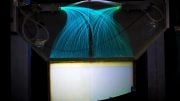

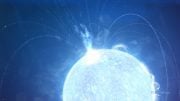
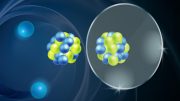
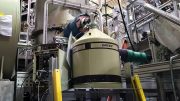
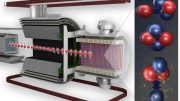
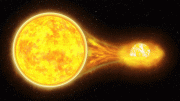
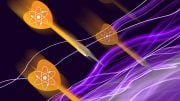
… a lot of physics on that scale is based on guess work, I guess. However, the quantum theory has proven it self again and again. Some info might be missing, but that is the best picture we might get. Some time ago, there was an experiment about proving that there are higher dimensions, and as I believe the gravity has been used.
The outcome was not positive. Well there are two objections>
– the gravity is bit odd on its own,
– could light be used for that, with regard to Kaluza-Klein….
by to you all, now!
Such a large discrepancy! You did not mention whether there were theoretical calculations that predict this lifetime accurately.
I’ve wondered about neutron decay for decades, It’s one of those little snags in my understanding, and I also suspect there is a mirror symmetry of the neutron built of a string type with different dimensionality, an orthoganaly-rotated version. My suspicion for the difference in decays between the two methods of measurement is the energy-density of the environment. In one experiment the neutrons are in a beam in vacuum, in the other they are being confined in proximity. Perhaps the energy-density, the charge field structures of the interacting neutrons in the bottle are acting to partially stabilize the neutrons, slowing their decay. That theory only has merit if the neutrons in the bottle are giving the larger lifetime measurement. The frustrating thing about this article is that they go on and on about the discrepancy in measurement, but they never identify which experiment measures which result. Did the neutrons survive longer in the beam, or in the bottle? They don’t tell us that crucial information in this article, so it is difficult to frame an idea of what might be causing it.
I’ve just learned alot today about neutrons that I was unaware of. Another article tells me the 3 quarks settle their internal fraction charges into a +ve sphere with an outer -ve shell which makes some sense. Perhaps that’s why protons can be glued together so well with enough neutron surface area to hold large atoms together, proton +ve surface to neutron -ve surface. In the nucleus the neutron lifetime is essentially eternity until it can be released from the nucleus.
And this article reminds us that at the beginning of the big bang, that the 15min neutron lifetime was enough to make the universe the way it is today, thats pretty mind boggling to think about, something like a butterfly effect there.
The article mentions the energy release, isn’t that exactly the mass-energy of the electron since that is the basis of the PP reaction in the stars and +ve beta decay.
Since the conditions of a neutron within the atom are so very different to those in the bottle and the beam experiments maybe the scientists should be focussing on trying to maximize the variation in the results instead of minimizing towards the same value. What ever effect can cause significant changes in the result would then explain the discrepancy.
Now I am wondering if the desire of the neutron to decay has some influence on the heavier nuclei atoms to decay at different rates and even if it could initiate radioactive decay.
Also would not an anti matter neutron have the surface and internal charge reversed, it would have to be that way to hold an anti matter nuclei together and can these be created in particle accelerators?
Thought, there is a Oscillation in the experiment the magnetic fields is created with AC current. in nature this oscillation does not inter in to the formula.